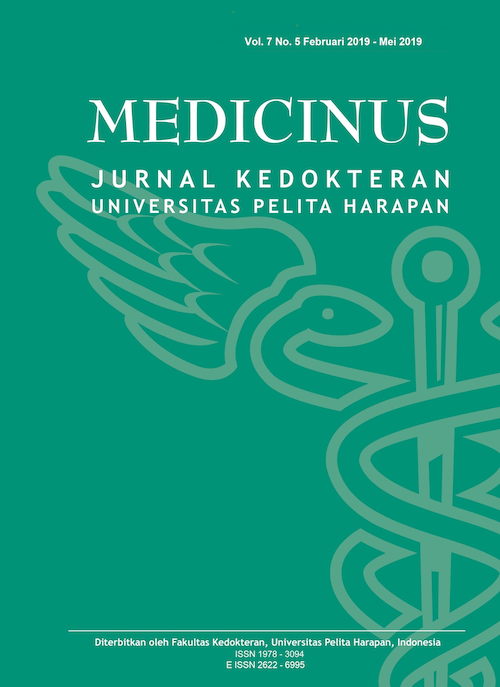Natural History and Risk Factors of Infantile Atopic Dermatitis: A Case Report and Literature Review
DOI:
https://doi.org/10.19166/med.v7i7.2762Trefwoorden:
Atopic dermatitis, infants, risk factorsSamenvatting
Atopic dermatitis (AD) or atopic eczema is one of the most common forms of pediatric dermatological skin conditions, primarily beginning in childhood with a variable natural course characterized by intense pruritus and eczematous lesions. This condition requires multifactorial interplay and risk factors to explain the pathogenesis. We hereby report a case of a two-month-old male who presented with widespread erythematous lesions, excoriations, and dry skin since one day before admission. The antenatal history showed use of antibiotics during pregnancy, familial history of atopy, and non-exclusive breastfeeding which are all known risk factors. Dermatological examination revealed skin phototype III with diffuse erythematous patches scattered on the face, trunk, upper and lower limbs, and groin followed with excoriations and palmar hyperlinearity. Further laboratory and histopathological examinations were not conducted. The patient was treated with topical corticosteroid and emollients, resulting in a notable improvement without any further flares. A thorough history taking and physical examination must be conducted to establish the diagnosis based on the Hanifin and Rajka criteria and identify risk factors such as genetic factors, impaired skin barrier, and environmental factors and microbial exposure, which may play a protective or harmful role in AD development. Holistic treatments consist of pharmacological and non-pharmacological treatments, with significant emphasis on education to the patient and caregiver(s) to improve quality of life and prevent exacerbations and infectious complications while minimizing potential medication side effects.Referenties
1. Boediardja SA. Dermatitis atopic. In: Menaldi SLSW, Bramono K, Indriati W, editors. Ilmu Penyakit Kulit dan Kelamin. Jakarta: Balai Penerbit Fakultas Kedokteran Universitas Indonesia; 2015. p. 167-83.
2. Tsai TF, Rajagopalan M, Chu CY, Encarnacion L, Gerber RA, Santos-Estrella P, et al. Burden of atopic dermatitis in Asia. Int. J. Dermatol. 2019 July; 2: 1-10. https://doi.org/10.1111/1346-8138.15048
3. Weidinger S, Novak N. Atopic dermatitis. Lancet. 2015 March; 387: 1109-22. https://doi.org/10.1016/S0140-6736(15)00149-X
4. Carrera YIL, Hammadi AA, Huang YH, Llamado LJ, Mahgoub E, Tallman AM. Epidemiology, Diagnosis, and Treatment of Atopic Dermatitis in the Developing Countries of Asia, Africa, Latin America, and the Middle East: A Review. Dermatol Ther. 2019 June; 9: 685-705. https://doi.org/10.1007/s13555-019-00332-3
5. Nutten S. Atopic Dermatitis: Global Epidemiology and Risk Factors. Ann Nutr Metab. 2015 April; 66: 8-16. https://doi.org/10.1159/000370220
6. Pyun BY. Natural History and Risk Factors of Atopic Dermatitis in Children. Allergy Asthma Immunol Res. 2015 March; 7: 101-5. https://doi.org/10.4168/aair.2015.7.2.101
7. Simpson EL, Leung DYM, Eichenfield LF, Boguniewicz M. Atopic Dermatitis. In: Kang S, Amagai M, Bruckner AL, Enk AH, Margolis DJ, McMichael AJ, Orringer JS, editors. Fitzpatrick's Dermatology. New York: McGraw-Hill Education; 2019. p. 363-84.
8. Tang MLK. Allergy prevention: Current recommendations and new insights. Aust. Fam. Physician. 2008 April; 37: 204-8.
9. Thomsen SF. Epidemiology and natural history of atopic diseases. Eur. Clin. Respir. J. 2015 February; 2: 1-6. https://doi.org/10.3402/ecrj.v2.24642
10. Flohr C, Silverberg JI, Wan J, Langan SM. Epidemiology of Atopic Dermatitis. In Hoeger P, Kinsler V, Yan A. Harper's Textbook of Pediatric Dermatology. 4th ed. New York: John Wiley & Sons Ltd.; 2020. p. 167-84. https://doi.org/10.1002/9781119142812.ch13
11. Rubel D, Thirumoorthy T, Soebaryo RW, Weng SCK, Gabriel TM, Villafuerte LL, et al. Consensus guidelines for the management of atopic dermatitis: An Asia-Pacific perspective. J Dermatol. 2013; 40(3): 160-71. https://doi.org/10.1111/1346-8138.12065
12. Eichenfield LF, Tom WL, Berger TG, Krol A, Paller AS, Schwarzenberger K, et al. Guidelines of care for the management of atopic dermatitis: Section 2. Management and treatment of atopic dermatitis with topical therapies. J Am Acad Dermatol. 2014; 71(1): 116-32. https://doi.org/10.1016/j.jaad.2014.03.023
13. Perhimpunan Dokter Spesialis Kulit dan Kelamin Indonesia (PERDOSKI). Panduan Praktik Klinis Bagi Dokter Spesialis Kulit dan Kelamin di Indonesia. Jakarta: PP PERDOSKI; 2017.
14. Perrett KP, Peters RL. Emollients for prevention of atopic dermatitis in infancy. Lancet. 2020; 395(10228): 923-4. https://doi.org/10.1016/S0140-6736(19)33174-5
15. Lopes A, Sokolova A, Abreu C, Lopes C. Atopic dermatitis host and environment model: Revisiting therapeutic options. Eur Ann Allergy Clin Immunol. 2020; 52(1): 4-14. https://doi.org/10.23822/EurAnnACI.1764-1489.125
16. Yang EJ, Sekhon S, Sanchez IM, Beck KM, Bhutani T. Recent developments in atopic dermatitis. Pediatrics. 2018; 142(4). https://doi.org/10.1542/peds.2018-1102
##submission.downloads##
Gepubliceerd
Citeerhulp
Nummer
Sectie
Licentie
Copyright (c) 2020 Paulus Mario Christopher, Maggie Stella Hung

Dit werk wordt verdeeld onder een Naamsvermelding-GelijkDelen 4.0 Internationaal licentie.
Authors who publish with this journal agree to the following terms:
1) Authors retain copyright and grant the journal right of first publication with the work simultaneously licensed under a Creative Commons Attribution License (CC-BY-SA 4.0) that allows others to share the work with an acknowledgement of the work's authorship and initial publication in this journal.
2) Authors are able to enter into separate, additional contractual arrangements for the non-exclusive distribution of the journal's published version of the work (e.g., post it to an institutional repository or publish it in a book), with an acknowledgement of its initial publication in this journal.
3) Authors are permitted and encouraged to post their work online (e.g., in institutional repositories or on their website). The final published PDF should be used and bibliographic details that credit the publication in this journal should be included.





